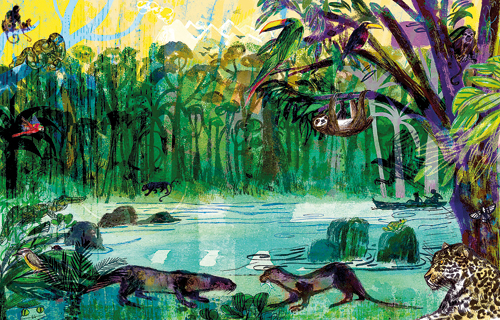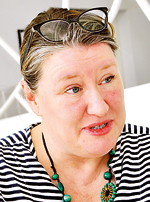In love with Scotland and drawing for children

‘Painterly, inky and messy: A Jill Calder illustration
Jill Calder hails me over a cappuccino, seated happily at Cinnamon Red with a bird’s eye view of Colombo which she tells me she loves. It seems quirky- meeting this warm Scotswoman with a brush that brought alive medieval Scotland with Robert the Bruce and indeed all corners of the world with her famous Picture Atlas.
Her illustrations have roots in her native Celtic world- one where nature has a Caledonian beauty of purple glen and gray loch- of fairy lore and and briny beach and heather mountain- and of darkness too- though a snug, lowering Scottish darkness with a red sun.
Illustrator and calligrapher, Jill here in Colombo for the British Council’s Drawing Words- was part of the exhibition of UK children’s book illustrations- and did a masterclass for adults and several workshops for children.
One of the first things she confesses to is a love for Scotland- but her raison d’être is drawing- and she is best known probably for her children’s art.
She loves to fill in her art with tiny details for children to observe and then go ‘cook in their brains’. But she sneaks in details for adults too- for the parents who read aloud- or for the grown up kids to return to those childhood idylls and recognize things they were once mystified by.
Jill herself didn’t have a lot of picture books as a child. She remembers loving the cover Quentin Blake did for the famous children’s novel The Cartoonist by Betsy Byars- ‘spiky, inky’ in signature Blake style. She also loved Richard Scarry books with its Busy Town- those full of cute animals getting upto all sorts of urban antics.
Her own art- now part of that tradition- she calls ‘painterly, inky and messy’. In some ways they seem improvements- more lively than Quentin Blake and loads more cheerful than Tomi Ungerer- whom she admires highly.
The first book Jill did was Robert the Bruce- a nonfiction children’s book written by James Robertson on the Scottish King. She plunged into medieval Scotland- talking to curators and historians- immersing herself in the 13th Century- and out of this came the rewarding book.

Jill Calder
Jill remembers a piece of advice slipped in by a fellow children’s artist at the Edinburgh Book Festival. “You should be able to draw children if you draw for them- because children like looking at themselves.”
And drawing children is a different art- given that their body scales are different- with larger heads. Something, says Jill, not grasped by the Renaissance artists whose cherubs and Baby Jesus are miniature versions of adults- and have nothing endearingly juvenile at all!
What Jill tips into her art is important- because in her whimsical drawings her love for the good things of life shine through. She reads a lot and loves words- but also gardening- which means plants grow with lush fecundity at the edges of her work- and good food.
Jill’s other vocation is calligraphy. When applying for jobs after art school, she sent postcards and would do rococo handwriting just to grab attention for her portfolio of art. Her first major design job came when the writing grabbed the attention of a firm who wanted her to be their calligrapher.
Calligraphy remains an art she does with verve- and each- from the frilliest to the simplest- is imbued with Jill’s own positive voice and personality.
Jill started making her own books for the pleasure of working totally manually. When drawing she uses digital technology to lend her creations an edge- so making books- out of wood, or using old stitches and antique bindings- takes her to something akin to the medieval world she has learnt to love so much.
Among other books she has drawn for are The Sea, The Ocean and What is Poetry? She has illustrated the pages of The Guardian, The Sunday Telegraph, BBC Wildlife Magazine and The New Yorker among others.
She loved the work put into Robert the Bruce so much, she wanted to go digging into the past again- and now has got another chance to create a new nonfiction children’s history book. Her eyes twinkle as she says “I can’t tell you anything else about it”.
You can see she is excited by the thought of all the deep sleuthing down museums and archives- bringing to life a lost world bit by bit- from caltrops to war horses to castles- resurrecting the past in all splendour and detail.
The Colombo British Council’s Drawing Words exhibition will go on till March 15, and will be open from 9 a.m. to 4.30 p.m., excepting Monday.


